|
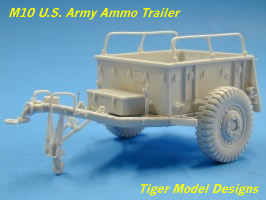 Tiger
Model Designs Tiger
Model Designs
353002
Tiger
Model Designs is gaining a reputation for filling in some significant holes in
the AFV modeling arsenal. In 2002 they came out with an M8 ammo trailer, and this
was joined by an M10 trailer kit in 2003. Trailers were an integral, if unglamorous,
part of the U.S. inventory during WWII. With the exception of the trailers found
in old Tamiya and Italeri jeep kits, and a few European resin kits, they've been
pretty much ignored by the modeling industry. Through these trailers and the release
of 105mm and 155mm ammo loads, TMD has seen an opportunity to help modelers and
dioramists render a more complete picture of the mechanics of warfare. 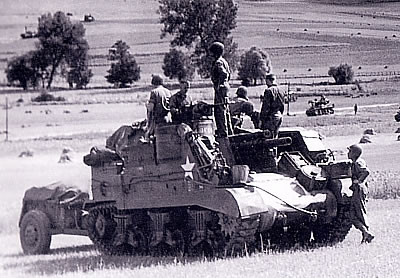 The
M10 trailer was designed to be towed by M7 Priests, M8 howitzer motor carriages,
and 105mm Shermans, as well as other vehicles. As noted in the instructions, the
M10 was produced by three companies from 1942 to 1945, and there were slight differences
in the finished pieces from these manufacturers. According to TM 9-2300, February,
1944, the trailer was designed to carry 117 rounds of 75mm howitzer ammo, 44 rounds
of 105mm ammo, or 16 rounds of 155mm. The
M10 trailer was designed to be towed by M7 Priests, M8 howitzer motor carriages,
and 105mm Shermans, as well as other vehicles. As noted in the instructions, the
M10 was produced by three companies from 1942 to 1945, and there were slight differences
in the finished pieces from these manufacturers. According to TM 9-2300, February,
1944, the trailer was designed to carry 117 rounds of 75mm howitzer ammo, 44 rounds
of 105mm ammo, or 16 rounds of 155mm.
While
I've used a lot of aftermarket kits to spruce up vehicles or build figures, this
is the first resin kit I've built of a complete vehicle. It presents some of the
challenges unique to building resin kits (fixing warped parts and limited working
time with superglue) as well as very complex assemblies, where fewer parts would
not compromise the finished product (sometimes less is more). So it's really geared
toward the skilled intermediate or advanced modeler. The
Kit 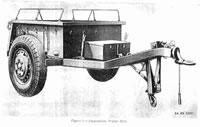 From
the viewpoint of accuracy, this certainly looks the part, but differs in measurements
from the TM 9-33 War Department Technical Manual information I found on Mike Canaday's
web site. The completed kit scales out to about 13'3" long, but the tech
manual states 12'2½". The TM cites an overall height of 4'9",
while the kit measures up to 4'6" at the top of side walls, or 5'6"
tall at the top of the rails. Width is similar at around 7'1". Ground clearance
in the manual calls for 17 ½" vs. 21" clearance for the model.
Again, this may be due to the variances between three manufacturers. From
the viewpoint of accuracy, this certainly looks the part, but differs in measurements
from the TM 9-33 War Department Technical Manual information I found on Mike Canaday's
web site. The completed kit scales out to about 13'3" long, but the tech
manual states 12'2½". The TM cites an overall height of 4'9",
while the kit measures up to 4'6" at the top of side walls, or 5'6"
tall at the top of the rails. Width is similar at around 7'1". Ground clearance
in the manual calls for 17 ½" vs. 21" clearance for the model.
Again, this may be due to the variances between three manufacturers.
There
are over 80 parts, including lengths of plastic rod, wire, and thin solder. Some
very fine chain is used for the back tailgate, and a sheet of lead foil for creating
straps (no buckles are included, however). The resin parts are formed from a compound
that produces soft castings with some flexibility to them, which is important
with the very thin pieces used for the wheel stand. If they were rigid, they would
easily snap in two. But the softer resin also means there is less resistance when
trimming the pieces from the casting blocks, so it's easier to carve off too much
from the pieces. Many of the parts are cast flush with the blocks, so there is
no margin for error. A fresh blade in your hobby knife, a steady hand, and good
lighting are necessary for this kit. Aside
from the challenges posed by the casting methods, the parts themselves have exceptional
detail and crispness. Some problems were encountered on individual pieces, where
worn or torn molds allowed some hollowed parts to be filled or produced minor
bumps that needed to be trimmed down. And while the parts are carefully packaged,
some pieces did have delicate pieces that were broken off. It's always a good
idea to carefully remove pieces from their plastic bags, as broken parts might
be inside. I had to contact TMB to replace the trailer frame and rear gate, as
they have little tabs that were broken and missing from the bag. Joe Bakanovic
quickly responded to my email with replacement parts. Another trailer feature,
the lunette unlocking lever ring, was broken from the frame neck, but I found
in the bag. Ultimately I decided to replace that with a ring of wire. The
eight full-sized pages of instructions are reasonably clear and straightforward,
with the building process broken down into 16 steps. There are no decals included,
but you could pull some bumper codes from spare decals or get trailer markings
from Archer Fine Transfers. Construction Most
steps in the instructions begin with the word "Carefully remove…"
and this is the order of the day with this kit. The
first significant challenge was faced in Step 1, which is the construction of
the two-piece frame and trailer body. The body had a large pour block on the bottom,
and the side walls were bowed inward. The frame on which the body rests was also
warped. A quick dip in boiling water (two to three seconds) is recommended in
the instructions. The problem with this, as far as the body goes, is straightening
the side walls while not deforming the floor of the body. It took me several attempts
to get the walls reasonably square, but the bottom rear corners of the piece did
lose some of their form, which became more apparent when fixing the piece to the
frame (part #2), which also had to be boiled and squared. There was also a lot
of sanding that had to be done to the pour block on the bottom of the body, even
though what remains is hidden by the frame. I tried to carve the edges of the
block down so it would fit within the frame, and ended up losing some of the square
edge on the corners of the body. It took me over an hour just to accomplish the
first step of construction. I was not satisfied with the way the body and the
supporting frame of piece #2 joined at the rear of the trailer, but since I plan
to use it with the gate open, this will be hidden. Steps
2 and 3 are relatively simple, adding the electrical box and handbrakes (which
can be fixed in released or applied positions). 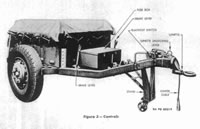 In
Step 4, construction begins on the intricate and very delicate jack-stand. This
starts with bending a section of wire for the jack-stand locking lever. A jig
is conveniently provided - through which you bend and shape the wire - as well
as a template showing how the finished bent wire should look. In the following
step, supports for the jack-stand and pieces to secure the lever to the frame
are slipped over the ends of the lever. In
Step 4, construction begins on the intricate and very delicate jack-stand. This
starts with bending a section of wire for the jack-stand locking lever. A jig
is conveniently provided - through which you bend and shape the wire - as well
as a template showing how the finished bent wire should look. In the following
step, supports for the jack-stand and pieces to secure the lever to the frame
are slipped over the ends of the lever.
Things
became a bit more difficult in Step 6, which begins the construction of the lower
section of the jack-stand. I had to use my hobby knife to drill out the holes
in the caster wheel and its retainer in order to get the .03" plastic rod
axle through. Part #E-3 was deformed by the mold, and had to be cleaned and drilled
out in order to slide the resin rod #E-5 through it, which in turn is sandwiched
into the frame #E-4. The
jack-stand is designed to be built so it can be collapsed (for traveling) or extended
(for static position). Because my finished locking lever resembled the template
example, but not exactly - some of the bends within the wire were not precisely
uniform - I wasn't sure if this might have an impact on the final assembly of
the frame of the jack-stand, because I did not know how precise the pieces for
the rest of the stand would fit, or if there was any tolerance for even the slightest
error. Added
to this, in Step 7, is the fact that you need to attach the frame arms (D-1) that
hang from the wire lever to two pieces (D-2) that extend (and slip off of) pins
on the frame, by means of another small length of .03" plastic rod - which
loosely slips through #E-3. So you are essentially trying to attach and glue five
pieces that have no fixed points, while not knowing if you do successfully fix
one side that the other side will be properly aligned due to the bends in the
wire lever. The
stand subassembly from Step 6 is supposed to slip into the retaining holes in
the trailer frame, and thus be able to swivel up and down while you're gluing
the pieces above. But I found that the resin rod #E-3 was too long and the subassembly
would not insert into the retaining holes without bending the rod. So I trimmed
away some of the circular wall around the retaining holes until I was able to
insert the subassembly. Sensing that I would quickly be driven mad by trying to
attach the aforementioned framing pieces to another unanchored piece, I glued
the subassembly in an extended position. This made it somewhat easier to attach
pieces D-1 and D-2, but only somewhat. This rapidly became an exercise in finger
positioning and patience, being mindful of not bending or breaking off the delicate
brake levers. Construction of this section took over an hour, during which time
I gave considerable thought to the advantages of offering two sets of pieces to
build either a folded or extended stand. Because you must glue the final assembly
in one position or the other, any advantage of building it as a workable unit
is quickly lost. And since the folded version requires precise building in order
to get the frame to "lock" onto the lever release, I can only imagine
how many attempts would be necessary to accomplish this small feat. Step
8 details the attachment of handles and the gooseneck hitch to the front end of
the frame. The attachment stub on the lunette (#F-1) is too large to fit into
the gooseneck. From tech manual photos of the real trailer, it appeared that just
a small amount of the stub on the lunette is seen, so I trimmed it down and glued
it to the gooseneck. You can attach the gooseneck to the frame in either a "high"
or "low" position. My plans are to use this with Tamiya's M8 HMC, which
requires the "low" position for hitching up to the back of the AFV.
Make sure you know the vehicle that will be pulling your trailer and you've accounted
for the height of its towing hitch before you attach the trailer's gooseneck. The
fuse box, in which fuses for arming the ordnance cargo were carried, is attached
in Step 9. The box has a large casting plug on its side that needs to be sawn
off - carefully - so as not to mar the lid of the box. There are slight corner
extensions on the side of the box without the plug, but these are not on the side
with the plug. Rather than trying to sculpt them on, I just carved them off the
other side, since they do not appear in the tech manual photos. It would have
been easier if the casting plug had been on the bottom of the box, rather than
the side. Step
10 finishes off the bottom side of the trailer, including the axle and protective
cover. In Step 11, the brake drums are attached to the axle ends. There are casting
plugs on the backsides of the drums and it's easy to carve too much off, losing
the lip of the drum. Before affixing the drums, however, you need to attach brake
cable receivers (parts B-1) to the drums. One was broken on the resin carrier,
but I found the tab in the bag and glued it to the receiver. The cable is fashioned
from snips of solder. The
next step includes attaching the very thin tire guards to the frame. One of mine
broke in two as I tried to remove if from the carrier. In this step you are also
supposed to attached the wheels. I left these off to paint separately. Note that
the tires have non-directional mud and snow pattern tread (similar to that seen
on most U.S. AFV kits like jeeps and halftracks), rather than the civilian tread
with the zigzag pattern around the circumference of the tires as was most often
seen on these trailers during the war. 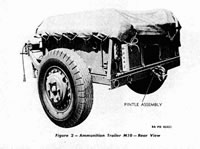 There
is a significant problem with the wheels, in that the lightening holes in the
retaining covers are filled in. There are no clear indications on the pieces where
exactly to carve them out except for one small dimple on each wheel piece. I thought
to replace the wheels with better defined spares from my scrap box, but the wheels
are significantly larger than those found on jeeps, halftracks, Dodge vehicles,
or even on the 105mm howitzer. So I'm at a bit of a loss as to what to do beyond
trying to precisely sculpt 24 lightening holes or slapping them with some well-concealing
"mud" come diorama time. (PSP makes a resin version of this trailer
with the civilian pattern tires, and from photos it appears they got the lightening
holes just right). There
is a significant problem with the wheels, in that the lightening holes in the
retaining covers are filled in. There are no clear indications on the pieces where
exactly to carve them out except for one small dimple on each wheel piece. I thought
to replace the wheels with better defined spares from my scrap box, but the wheels
are significantly larger than those found on jeeps, halftracks, Dodge vehicles,
or even on the 105mm howitzer. So I'm at a bit of a loss as to what to do beyond
trying to precisely sculpt 24 lightening holes or slapping them with some well-concealing
"mud" come diorama time. (PSP makes a resin version of this trailer
with the civilian pattern tires, and from photos it appears they got the lightening
holes just right).
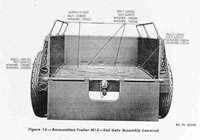 Step
13 returns to the rear of the trailer, where the brake lights, bumper, trailer
hitch, and tailgate are installed. In Step 14, the two distinctive rails on the
tops of the trailer side walls are attached, angled inward. Each rail has three
attachment points, which are sandwiched between tabs that must fit on small plates
molded onto the top of the trailer sides. To accomplish this, I had to thin down
the flattened ends of the rails. Then I glued one set of "left side"
tabs to the wall, and then glued the rail, then the tabs on the other side of
the rail. Because the molded-on plates have raised screws that these three pieces
need to fit between, the parts bow outward unless they are thinned down considerably.
This is another "less is more" situation, because there is no advantage
to the modeler for having these as separate pieces. It would have been better
if the tabs had been molded to ends of the rail, or the tabs and plates had been
molded together as single pieces into which the rail was inserted. Step
13 returns to the rear of the trailer, where the brake lights, bumper, trailer
hitch, and tailgate are installed. In Step 14, the two distinctive rails on the
tops of the trailer side walls are attached, angled inward. Each rail has three
attachment points, which are sandwiched between tabs that must fit on small plates
molded onto the top of the trailer sides. To accomplish this, I had to thin down
the flattened ends of the rails. Then I glued one set of "left side"
tabs to the wall, and then glued the rail, then the tabs on the other side of
the rail. Because the molded-on plates have raised screws that these three pieces
need to fit between, the parts bow outward unless they are thinned down considerably.
This is another "less is more" situation, because there is no advantage
to the modeler for having these as separate pieces. It would have been better
if the tabs had been molded to ends of the rail, or the tabs and plates had been
molded together as single pieces into which the rail was inserted.
Seventeen
tie-down cleats are attached to the trailer sides in Step 15. You have the option
of resin cleats, or fashioning your own out of wire with the template included
in the kit. I opted for the resin pieces, but quickly found that the ends that
need to be attached were rounded and didn't provide much contact surface for gluing.
I nipped them down with my knife. It appears you should glue them to the edge
of the plates that are molded onto the trailer sides but the contact area is not
well defined, so I positioned them right above the plates. Step
16 addresses the optional addition of 31 tie-downs throughout the lower interior
of the trailer through which straps secured ammo loads. If you have a full load
you can easily ignore this step and just wrap some lead foil straps around the
contents to secure them. Construction
took about 10 hours over the course of several days. Conclusion As
I said, this little kit is really for the more experienced modeler with strong
nerves, nimble fingers, and eagle eyes. Even with its complexity being arguably
a case of overkill, it builds up - with care - into a very nice model. TMD
has two ammo load kits available for their trailers. While their 105mm load has
been temporarily pulled from the market because of some accuracy problems with
the ammo bundles, their 155mm load set is correct and provides 18 rounds and 9
charges in metal canisters. AFV Club also has a set of 155mm and 203mm rounds
and charge canisters, but note that their decals are for post-WWII ordnance. Verlinden
also produces 105mm and 155mm howitzer rounds; their 75mm howitzer rounds have
been out of production for several years, unfortunately. While
designated as an ammo hauler it can be safely assumed that GIs would fill it with
anything they needed to carry with them that couldn't find a space on or in their
vehicle. So jerry cans, sidearms ammo, bedrolls and haversacks, etc. certainly
found their way into any trailers.
Review sample kindly provided by Tiger Model Designs.
-tss- | 











